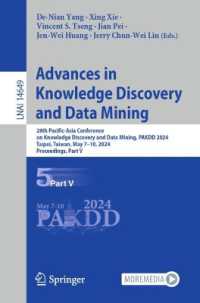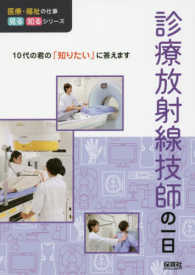- ホーム
- > 洋書
- > 英文書
- > Computer / General
Full Description
The 10-volume set LNAI 15201-15210 constitutes the proceedings of the 17th International Conference on Intelligent Robotics and Applications, ICIRA 2024, which took place in Xi'an, China, during July 31-August 2, 2024.
The 321 full papers included in these proceedings were carefully reviewed and selected from 489 submissions.
They were organized in topical sections as follows:
Part I: Innovative Design and Performance Evaluation of Robot Mechanisms.
Part II: Robot Perception and Machine Learning; Cognitive Intelligence and Security Control for Multi-domain Unmanned Vehicle Systems.
Part III: Emerging Techniques for Intelligent Robots in Unstructured Environment; Soft Actuators and Sensors; and Advanced Intelligent and Flexible Sensor Technologies for Robotics.
Part IV: Optimization and Intelligent Control of Underactuated Robotic Systems; and Technology and application of modular robots.
Part V: Advanced actuation and intelligent control in medical robotics: Advancements in Machine Vision for Enhancing Human-Robot Interaction; and Hybrid Decision-making and Control for Intelligent Robots.
Part VI: Advances in Marine Robotics; Visual, Linguistic, Affective Agents: Hybrid-augmented Agents for Robotics; and Wearable Robots for Assistance, Augmentation and Rehabilitation of human movements.
Part VII: Integrating World Models for Enhanced Robotic Autonomy; Advanced Sensing and Control Technologies for Intelligent Human-Robot Interaction; and Mini-Invasive Robotics for In-Situ Manipulation.
Part VIII: Robot Skill Learning and Transfer; Human-Robot Dynamic System: Learning, Modelling and Control; AI-Driven Smart Industrial Systems; and Natural Interaction and Coordinated Collaboration of Robots in Dynamic Unstructured Environments.
Part IX: Robotics in Cooperative Manipulation, MultiSensor Fusion, and Multi-Robot Systems; Human-machine Co-adaptive Interface; Brain inspired intelligence for robotics; Planning, control and application of bionic novel concept robots; and Robust Perception for Safe Driving.
Part X: AI Robot Technology for Healthcare as a Service; Computational Neuroscience and Cognitive Models for Adaptive Human-Robot Interactions; Dynamics and Perception of Human-Robot Hybrid Systems; and Robotics for Rehabilitation: Innovations, Challenges, and Future Directions.
Contents
.- .Advances in Marine Robotics.
.- AUV control system interface development based on Qt platform.
.- Improved Multi-objective Particle Swarm Algorithm for AUV Path Planning in Ocean Currents Environment.
.- Dynamics Analysis of Reconfigurable Underwater Vehicle-Manipulator System for Docking Application.
.- Learning-Based Model Predictive Control for Addressing Model Mismatch in AUV Trajectory Tracking.
.- Disturbance Rejection MPC for Tracking of Autonomous Underwater Vehicle.
.- Kalman Filter-based acoustic guidance docking system for autonomous underwater vehicle.
.- Informative Path Planning for Multi-UUV Cooperative Search with Distributed Q-Learning.
.- A Novel Ocean Current Prediction Algorithm Based On Attention LSTM Neural Network.
.- Depth tracking control of unmanned underwater vehicle with roll suppression.
.- Development of a Cleaning ROV for High-Temperature Radioactive Environment.
.- Research on Underwater Grasper with Non-Contact Swirling Suction Cups.
.- Lightweight Maritime Ship Object Detection Based on YOLOv7-Tiny.
.- Fish surface damage detection with improved YOLOv7.
.- Visual, Linguistic, Affective Agents: Hybrid-augmented Agents for Robotics.
.- Fast Visual-Inertial Odometry with Adaptive Feature Coupling.
.- Sentiment Caption Generation from Visual Scene Using the Pre-trained Language Model.
.- Recognition and Grasping of 3D Printed Concrete Reinforced Structural Parts Based on Visual Guidance.
.- Innovations in Real-Time Measurement of Parcel Volume via Depth Map Collision Line Tracing Techniques.
.- Research on Road Defect Detection Algorithm Based on LD-YOLOv8.
.- SK-EEGNet: A Novel Multiscale EEGNet Improved by SKNet for RSVP-based Target Detection.
.- Playing Non-Embedded Card-Based Games with Reinforcement Learning.
.- A Two-step Measuring Method of Reference Holes in Robotic Drilling of Large Component.
.- Few-Shot N-Ary Knowledge Inference Using Large Language Models.
.- Sim-to-Real Control of Trifinger Robot by Deep Reinforcement Learning.
.- BSGM: Psychological State Analysis Method Based on Deep Learning and Stock Market Dynamic Data Augmentation.
.- Enhancing Troubleshooting Task-Oriented Dialog Systems with Large Language Models.
.- Wearable Robots for Assistance, Augmentation and Rehabilitation of human movements.
.- Adaptive position-based visual servoing of robot manipulators with pose observers.
.- Design and Development of a Five-Degree-of-Freedom Knee Joint Rehabilitation Robot with Multimode Signal Monitoring.
.- A miniature programmable multichannel sensory feedback device with electrotactile and vibrotactile modalities for amputees.
.- Test-Based Model-Free Adaptive Iterative Learning Control for Trajectory Tracking of a Pneumatic Ankle-Foot Exoskeleton.
.- Sensorless Safe Interaction Method for Novel Tendon-driven SuperLimb Based on Dynamic Parameter Identification.
.- IMU-Based Human Ground Reaction Force Estimation Method.
.- A medical robot based on an improved water-bomb origami continuum.
.-Design of a Bidirectional Force-feedback Exoskeleton Glove.
.- Dynamic Optimization of Spatial Parallel Robot with Lubrication Clearance.








